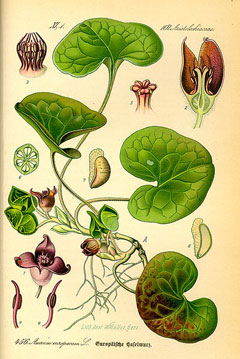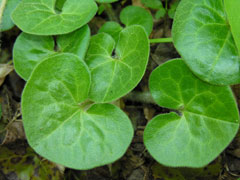 |
|
http://commons.wikimedia.org/wiki/File:Illustration_Asarum_europaeum0.jpg |
 |
| http://lt.wikipedia.org/wiki/Naudotojas:Algirdas |
Translate this page:
Summary
Bloom Color: Purple.
Main Bloom Time: Early spring, Late spring, Mid spring. Form: Spreading or horizontal.
Physical Characteristics

 Asarum europaeum is an evergreen Perennial growing to 0.1 m (0ft 4in) by 0.5 m (1ft 8in) at a slow rate.
Asarum europaeum is an evergreen Perennial growing to 0.1 m (0ft 4in) by 0.5 m (1ft 8in) at a slow rate.
See above for USDA hardiness. It is hardy to UK zone 4. It is in leaf all year, in flower from May to August. The species is hermaphrodite (has both male and female organs) and is pollinated by Flies. The plant is self-fertile.
Suitable for: light (sandy), medium (loamy) and heavy (clay) soils and prefers well-drained soil. Suitable pH: mildly acid, neutral and basic (mildly alkaline) soils. It can grow in full shade (deep woodland) or semi-shade (light woodland). It prefers moist soil.
UK Hardiness Map
US Hardiness Map
Synonyms
Plant Habitats
Woodland Garden Dappled Shade; Shady Edge; not Deep Shade; Ground Cover;
Edible Uses
References More on Edible Uses
Medicinal Uses
Plants For A Future can not take any responsibility for any adverse effects from the use of plants. Always seek advice from a professional before using a plant medicinally.
Cathartic Diaphoretic Emetic Errhine Sternutatory Stimulant Tonic
Asarabacca has a long history of herbal use dating back at least to the time of the ancient Greeks, though it is little used in modern herbalism[268]. The root, leaves and stems are cathartic, diaphoretic, emetic, errhine, sternutatory, stimulant and tonic[4, 7, 9, 13, 21, 46, 240]. The plant has a strong peppery taste and smell[244]. It is used in the treatment of affections of the brain, eyes, throat and mouth[4, 19]. When taken as a snuff, it produces a copious flow of mucous[268]. The root is harvested in the spring and dried for later use[7]. Use with caution[21], see the notes above on toxicity. An essential oil in the root contains 50% asarone and is 65% more toxic than peppermint oil[240]. This essential oil is the emetic and expectorant principle of the plant and is of value in the treatment of digestive tract lesions, silicosis, dry pharyngeal and laryngeal catarrh etc[240].
References More on Medicinal Uses
The Bookshop: Edible Plant Books
Our Latest books on Perennial Plants For Food Forests and Permaculture Gardens in paperback or digital formats.

Edible Tropical Plants
Food Forest Plants for Hotter Conditions: 250+ Plants For Tropical Food Forests & Permaculture Gardens.
More

Edible Temperate Plants
Plants for Your Food Forest: 500 Plants for Temperate Food Forests & Permaculture Gardens.
More

More Books
PFAF have eight books available in paperback and digital formats. Browse the shop for more information.
Shop Now
Other Uses
Dye
A vibrant apple-green dye is obtained from plant[7, 244]. A useful ground cover for a shady position so long as it is not dry[197], spreading by its roots[208].
Special Uses
Food Forest Ground cover Scented Plants
References More on Other Uses
Cultivation details
Landscape Uses:Border, Ground cover, Massing, Rock garden, Woodland garden. Prefers a rich moist neutral to acid soil in woodland or a shady position in the rock garden[1, 200]. Other reports say that this plant prefers a calcareous soil[13, 19, 268]. Plants are hardy to at least -15°c[200]. The flowers are malodorous and are pollinated by flies[200]. The root has a pungent, aromatic smell like mild pepper and ginger mixed, but more strongly aromatic. Plants often self-sow when growing in a suitable position[200]. This plant was at one time commonly cultivated as a medicinal herb[17]. Special Features:
Attractive foliage, Not North American native, Naturalizing, Inconspicuous flowers or blooms.
References Carbon Farming Information and Carbon Sequestration Information
Temperature Converter
Type a value in the Celsius field to convert the value to Fahrenheit:
Fahrenheit:
The PFAF Bookshop
Plants For A Future have a number of books available in paperback and digital form. Book titles include Edible Plants, Edible Perennials, Edible Trees,Edible Shrubs, Woodland Gardening, and Temperate Food Forest Plants. Our new book is Food Forest Plants For Hotter Conditions (Tropical and Sub-Tropical).
Shop Now
Plant Propagation
Seed - best sown in a cold frame as soon as it is ripe in the summer[134]. Stored seed will require 3 weeks cold stratification and should be sown in late winter[134]. The seed usually germinates in the spring in 1 - 4 or more weeks at 18°c[134]. When large enough to handle, prick the seedlings out into individual pots and grow them on in light shade in the greenhouse for at least their first winter. Plant them out when large enough in late spring. Division in spring or autumn. Plants are slow to increase[200]. It is best to pot the divisions up and keep them in light shade in the greenhouse until they are growing away strongly.
Other Names
If available other names are mentioned here
Native Range
TEMPERATE ASIA: Turkey (n.w. & n.e.), Georgia, Russian Federation-Western Siberia (Western Siberia (south)) EUROPE: Finland (south), Austria, Belgium, Switzerland, Czech Republic, Germany, Hungary, Poland, Slovakia, Russian Federation (European part), Belarus, Estonia, Lithuania, Latvia, Moldova, Ukraine (incl. Krym), Albania, Bulgaria, Bosnia and Herzegovina, Greece (north), Croatia, Italy, North Macedonia, Montenegro, Romania, Serbia, Slovenia, France
Weed Potential
Right plant wrong place. We are currently updating this section.
Please note that a plant may be invasive in one area but may not in your area so it's worth checking.
Conservation Status
IUCN Red List of Threatened Plants Status :

Growth: S = slow M = medium F = fast. Soil: L = light (sandy) M = medium H = heavy (clay). pH: A = acid N = neutral B = basic (alkaline). Shade: F = full shade S = semi-shade N = no shade. Moisture: D = dry M = Moist We = wet Wa = water.
Now available:
Food Forest Plants for Mediterranean Conditions
350+ Perennial Plants For Mediterranean and Drier Food Forests and Permaculture Gardens.
[Paperback and eBook]
This is the third in Plants For A Future's series of plant guides for food forests tailored to
specific climate zones. Following volumes on temperate and tropical ecosystems, this book focuses
on species suited to Mediterranean conditions—regions with hot, dry summers and cool, wet winters,
often facing the added challenge of climate change.
Read More
Expert comment
Author
L.
Botanical References
200
Links / References
For a list of references used on this page please go here
Readers comment
© 2010, Plants For A Future. Plants For A Future is a charitable company limited by guarantee, registered in England and Wales. Charity No. 1057719, Company No. 3204567.